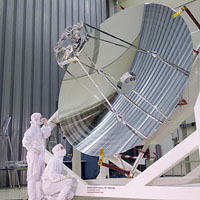Feb 9 2008
ESA's test centre is buzzing with activity and anticipation as it welcomes its latest guest. The gigantic telescope of ESA's space-based infrared observatory, Herschel, is being prepared to be assembled with its spacecraft in the next few weeks.

Herschel's telescope, which will carry the largest mirror ever flown in space, has just been delivered to ESA's European Space Research and Technology Centre, ESTEC. Here, engineers and scientists are busy with the final steps that will prepare the infrared observatory for launch in late 2008.
The 3.5-m diameter technological marvel is made from 12 silicon-carbide petals brazed together to form a single structure and coated with a layer of reflective aluminium, forming a remarkably lightweight mirror. The fully-assembled telescope, which includes the primary mirror, the secondary mirror and its support structure, is a feathery 320 kg; remarkably low for such a sturdy structure capable of withstanding high launch loads and functioning precisely in the harsh environment of space.
It is this powerful telescope that will allow scientists to look deep into space, at long infrared wavelengths. Herschel's spectral coverage, which ranges from far-infrared to sub-millimetre wavelengths, will be made available for space-based observations for the first time. This will make it possible to observe and study relatively cool objects everywhere in the universe, from our own back yard to distant galaxies, teaching us much more about the birth and evolution of stars and galaxies.
The next step is testing the telescope's interface with the spacecraft. Additionally, the mirrors will be tested for optical and mechanical stability.
First, the solar array and sunshield will be integrated with the cryostat, which was mated with the service module in September last year. Once this is done, the telescope will be ready to be mated, completing the spacecraft. The spacecraft will then undergo extensive environmental and functional tests before being shipped to Kourou for the launch campaign.